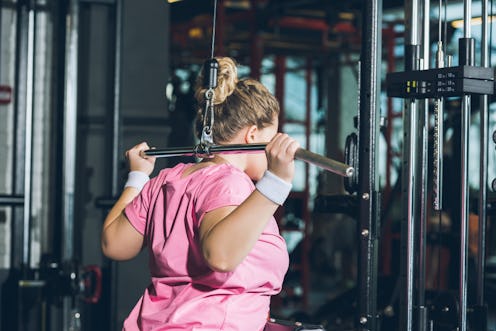Life
“No Pain, No Gain” Is A Common Fitness Mantra. It’s Also Wildly Toxic.

This piece is part of Bustle’s All Levels Welcome, a column about making fitness culture as accessible and inclusive as possible.
Especially around the beginning of the year, people hear a lot of popular fitness slogans: No excuses. The only bad workout is no workout. No pain, no gain. While they purport to be "inspiring," these phrases can shame people into believing that their self-worth is dictated by how hard they go in the gym. This attitude towards exercise also shuts out people who need to take breaks or avoid certain kinds of movement for their health. Taking cues from people with chronic illnesses and disabilities navigating their own relationships with exercise can help everyone unlearn these toxic tropes.
When Saylor, 21, was diagnosed with Ehlers-Danlos Syndrome at age 18, the pressure to perform fitness according to those standards proved dangerous. "I pushed myself too hard nine times out of 10 and ended up needing a day in bed," she tells Bustle. Ehlers-Danlos is a connective tissue disorder that can lead to having dangerously hypermobile joints; while exercise is shown to help strengthen weakened joints, pushing too hard in the gym can result in flareups. "I live in chronic pain daily, all day, and I didn't realize that the pain non-disabled people feel when they push too hard in the gym is just my daily pain." Being cognizant of her daily pain levels have helped Saylor develop an understanding of when and how her body can benefit from working out.
Now, she says, "my relationship to fitness is less about 'looking good' and more about 'strengthening my weakened joints to be better for myself.'" When Saylor works out, she now focuses on isometric and bodyweight work, always modified to suit her day-to-day needs.
Making the modifications that your body might need can be very tough, given the assumptions that you have to "push through pain" in order to get a "real" workout. This attitude deeply impacted Declan, 37, who lives with chronic joint pain and Familial Adenomatous Polyposis, an inherited tendency to form potentially malignant polyps in the colon, which for Declan led to a colon cancer diagnosis at age 27.
"Before my chronic illness, I would just push until I couldn't push anymore," he says. "Now between my chronic illness and the mobility issues and pain that I deal with on a daily basis, I've had to learn to admit that pushing doesn't work for me anymore."
Pushing through emotional and physical pain doesn't work for most people, science says. A 2019 study published in the journal Body Image found that people are less likely to work out when they are “encouraged” to do so in ways that shame and embarrass them — for example, being told that not working out makes them and their bodies less than and “lazy.” Being shamed into working out just doesn’t work, the study concluded.
Even when someone does want to work out, “pushing through the pain” is simply not safe or possible for many people, whether they live with disabilities or if they're still getting used to a certain kind of movement. For many people, including Saylor, gyms can be emotionally inaccessible spaces to begin with, because non-disabled people often stare at her when she modifies exercises to suit her needs. And according to a 2018 study published in the Disability and Health Journal, part of the intimidation and embarrassment surrounding gyms is the fact that the gyms are often physically inaccessible to people with various disabilities. The combined social pressure to "push through pain" even when it's not safe, the emotional burden of being stared at, and the physical risks of inaccessible equipment can create a perfect storm of making people feel like they need to put themselves at risk in order to be "fit."
Emotional and physical inaccessibility are not the only obstacles created by the "no excuses" model, however. Fitness facilities often assume that you can and should use the gym frequently enough to make your membership financially worth it. But Declan tells Bustle, "If I'm laid up due to complications from chronic illness, need a medical procedure, or have severe complication requiring a 10-day hospital stay and three months' recovery at home, there goes a ton of pay." Taking weeks or months off from the gym when chronic illness and pain flares up isn't feasible for most people.
Declan encourages people to work out in their own way, no matter what that means. "Sometimes that's not a workout at the gym, it's a walk around the neighborhood, and that's OK," he says. Listening to your body is the most important thing.
Saylor tells Bustle that redefining fitness is fundamentally about respect for all bodies. "Stop treating disabled people like we can't exercise, and then like we're amazing when we do exercise," she says. "Respect us when we say we're not up to exercising in that day or that time in the day, but also don't limit us if we say we're up to something. Respect our limits and our strengths."
If you’re not exercising like the mainstream fitness industry says you "should" be, know that you don’t have to buy into the shaming idea that you’re “making excuses” or “being lazy.” Your worth as a person is not tied to the ways that you do or don’t work out — your worth as a person is, always, so much more than that.
This article was originally published on